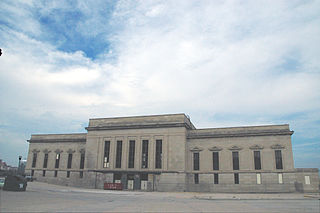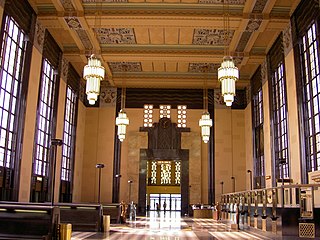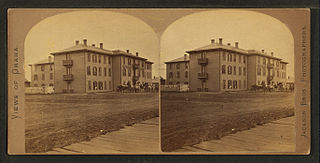Related Research Articles

Omaha is the largest city in the state of Nebraska and the county seat of Douglas County. Omaha is in the Midwestern United States on the Missouri River, about 10 miles (15 km) north of the mouth of the Platte River. The nation's 40th-largest city, Omaha's 2019 estimated population was 478,192.
The history of North Omaha, Nebraska includes wildcat banks, ethnic enclaves, race riots and social change spanning over 200 years. With a recorded history that pre-dates the rest of the city, North Omaha has roots back to 1812 with the founding of Fort Lisa. It includes the Mormon settlement of Cutler's Park and Winter Quarters in 1846, a lynching before the turn-of-the-twentieth-century, the thriving 24th Street community of the 1920s, the bustling development of the African-American community through the 1950s, a series of riots in the 1960s, and redevelopment in the late 20th and early 21st century.

Omaha station, located at 1001 South 10th Street in downtown Omaha, Nebraska, is a historically and culturally significant landmark, and is listed on the National Register of Historic Places, which is currently used as the studio facility for Omaha's ABC affiliate, television station KETV. When it was opened in 1898, this Italianate style building, designed by Thomas Rogers Kimball, was hailed by newspapers around the world for its grand architecture and accommodations. The station is a contributing property to the Omaha Rail and Commerce Historic District, and sits southeast of the Old Market, and immediately north of Little Italy.

The Union Station, at 801 South 10th Street in Omaha, Nebraska, known also as Union Passenger Terminal, is "one of the finest examples of Art Deco architecture in the Midwest." Designated an Omaha Landmark in 1978, it was listed as "Union Passenger Terminal" on the National Register of Historic Places in 1971, and was designated a National Historic Landmark in 2016. The Union Station is also a contributing property to the Omaha Rail and Commerce Historic District. It was the Union Pacific's first Art Deco railroad station, and the completion of the terminal "firmly established Omaha as an important railroad terminus in the Midwest."
Mexicans in Omaha are people living in Omaha, Nebraska, United States who have citizenship or ancestral connections to the country Mexico. They have contributed to the economic, social and cultural well-being of Omaha for more than a century. Mexicans, or Latino people identified incorrectly as being from Mexico, have been accounted for in the history of Omaha, Nebraska since 1900. The entire Latino population of Omaha increased ninety percent between 1990 and 1997.

Downtown Omaha is the central business, government and social core of the Omaha-Council Bluffs metropolitan area, U.S. state of Nebraska. The boundaries are Omaha's 20th Street on the west to the Missouri River on the east and the centerline of Leavenworth Street on the south to the centerline of Chicago Street on the north, also including the CHI Health Center Omaha. Downtown sits on the Missouri River, with commanding views from the tallest skyscrapers.

Alfred D. Jones was a late 19th-century lawyer, surveyor and politician in the Midwestern United States. In 1846 he platted Fort Des Moines, Iowa, and in 1854 he platted Omaha, Nebraska. He became the first settler in Omaha, as well as the first postmaster, a member of the first Omaha City Council and the first Omaha School Board, and was among the first legislators of the Nebraska Territory.

Transportation in Omaha, Nebraska, includes most major modes, such as pedestrian, bicycle, automobile, bus, train and airplane. While early transportation consisted of ferries, stagecoaches, steamboats, street railroads, and railroads, the city's transportation systems have evolved to include the Interstate Highway System, parklike boulevards and a variety of bicycle and pedestrian trails. The historic head of several important emigrant trails and the First Transcontinental Railroad, its center as a national transportation hub earned Omaha the nickname "Gate City of the West" as early as the 1860s.

Railroads in Omaha, Nebraska, have been integral to the growth and development of the city, the state of Nebraska, the Western United States and the entire United States. The convergence of many railroad forces upon the city was by happenstance and synergy, as none of the Omaha leaders had a comprehensive strategy for bringing railroads to the city.
The Port of Omaha is a port of entry in the United States with facilities on the west side of the Missouri River in Omaha, Nebraska. The official address is located at 5229 Boeing Court in East Omaha. The Port was formally sanctioned by the U.S. Congress in 1888.
Augustus Kountze was an American businessman based in Omaha, Nebraska, Kountze, Texas and New York City. He founded a late 19th-century national banking dynasty along with his brothers Charles, Herman and Luther.

The Cozzens House Hotel, later known as the Canfield House, was a pioneer hotel located at 9th & Harney Streets in downtown Omaha, Nebraska. Constructed in by Union Pacific promoter George Francis Train, the 120-room hotel cost $60,000 to build in 1867. The hotel was widely regarded as the finest hotel between Chicago, Illinois and San Francisco, California when it was constructed.

Dr. George Lorin Miller (1830–1920) was a pioneer physician, editor, politician, and land owner in Omaha, Nebraska. The founder of the Omaha Herald, which later became part of the Omaha World-Herald, Miller arrived in Omaha in 1854, the year the city was founded. He also promoted Omaha as the route of the First Transcontinental Railroad and the Trans-Mississippi and International Exposition in Omaha in 1898.
The Omaha and Council Bluffs Railway and Bridge Company, known as O&CB, was incorporated in 1886 in order to connect Omaha, Nebraska with Council Bluffs, Iowa over the Missouri River. With a sanctioned monopoly over streetcar service in the two cities, the O&CB was among the earliest major electric street railway systems in the nation, and was one of the last streetcar operators in the U.S., making its last run in 1955.
The Omaha Horse Railway was a private transportation company in early Omaha, Nebraska. The company was founded in 1867 by Omaha pioneers Ezra Millard, Andrew J. Hanscom and Augustus Kountze to provide horsecar service in the city. On February 19 of that year the Nebraska Territory Legislature awarded the company a 50-year franchise and exclusive rights to run tracks on Omaha's streets in its closing session. The company was noted for an 1888 United States District Court trial in which they sued another company for infringing on the exclusive rights to Omaha's streets granted to them by the Nebraska Territory Legislature.
The Herndon House, later known as the International Hotel and then the Union Pacific Headquarters, was an early hotel located at Ninth and Farnam Streets in present-day Downtown Omaha, Nebraska. Built in 1858 by Omaha pioneer Dr. George L. Miller along with several associates, it was financed by the sale of city-donated land and a $16,000 loan. It was used as the headquarters building of the Union Pacific Railroad for more than 50 years; it was demolished in 1922.

Bronx Park Terminal was a terminal station on the demolished IRT Third Avenue Line in the Bedford Park neighborhood of the Bronx in New York City. The station was located adjacent to Bronx Park and the New York Botanical Garden at 198th Street between Webster Avenue and Southern Boulevard, in the approximate location of the modern Fordham Preparatory School. It was opened on May 21, 1902 and closed on November 14, 1951. The next southbound stop was Fordham Road – 190th Street.
Frost & Granger was an architectural partnership from 1898 to 1910 of brothers-in-law Charles Sumner Frost (1856–1931) and Alfred Hoyt Granger (1867–1939). Frost and Granger were known for their designs of train stations and terminals, including the now-demolished Chicago and North Western Terminal, in Chicago. The firm designed several residences in Hyde Park, Illinois, and many other buildings. Several of their buildings are listed on the U.S. National Register of Historic Places.
Joseph P. Guth was a popular civil engineer, architect and builder in Omaha, Nebraska starting in the 1880s.
References
- ↑ Federal Writers' Project (1947) Nebraska, a guide to the Cornhusker State. Nebraska State Historical Society. p 218.
- ↑ Kratville, W. (2003). Railroads of Omaha and Council Bluffs. Arcadia Publishing. p. 75.
- ↑ "How baggage is handled" (PDF). New York Times. 1902-03-02. Retrieved 2008-02-18.
- ↑ "Swedish Churches in Omaha: Sites and survivals", Retrieved 11/13/10.
| This Nebraska train station-related article is a stub. You can help Wikipedia by expanding it. |